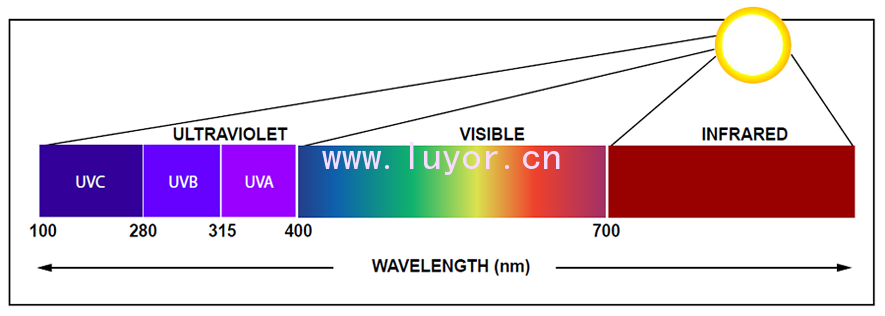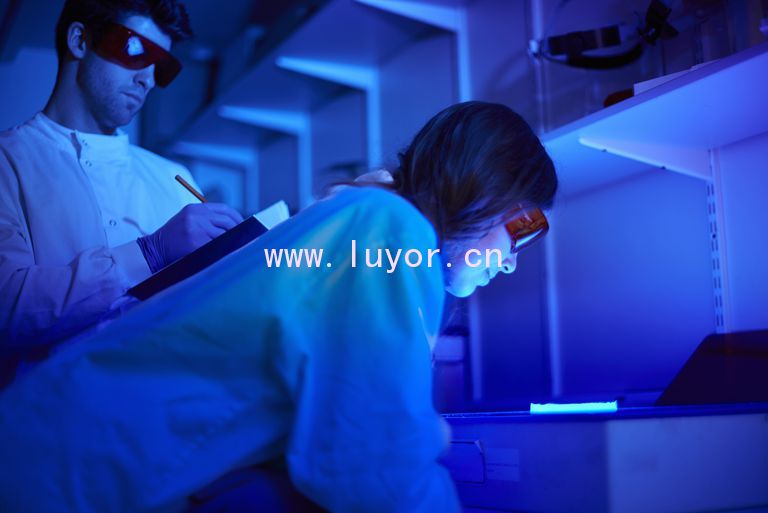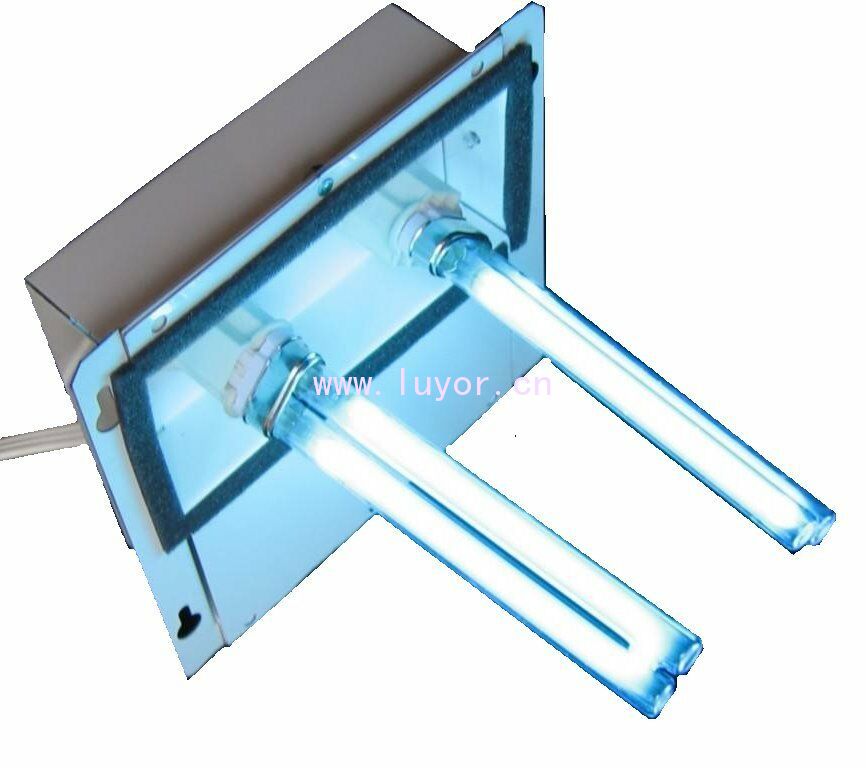一套荧光检漏套装解决工业设备泄漏
LUYOR-6801荧光检漏仪是美国路阳公司生产的荧光检漏仪套装,适用于检查小到中等规模的油基液体系...
2024-03-28作者:紫外光源事业部时间:2020-02-21 14:29浏览4435 次
UV-A照明系统主要用于喷漆房和生产现场。灯具用于加快固化过程,使企业可以提高生产率和生产率。在使用过程中,操作员在表面上涂一层底涂层,该底涂层由液体单体,液体低聚物和光引发剂组成。然后施用UV-A带以活化分子。油漆固化过程大约需要30-125秒。
紫外线(UV)以自然阳光的形式存在于我们周围。在工业领域,不可见光具有广泛的应用,从涂料固化和无损检测(NDT)到化学分析和假冒检测。在光谱范围内,可以在伽玛/ x射线和可见光范围之间找到紫外线带。
具体来说,短波紫外线范围位于红外和微波的相对侧,而红外和微波是长波段的组。紫外线的测量范围在100纳米至400纳米之间-对于特定应用,有时可达430纳米。在紫外线范围的高端,谱带与可见光谱(400+ nm)重叠,从而产生稍微可见的“紫”输出。
UV范围分为三部分:UV-A,UV-B和UV-C。每个小组都有自己的一套独特的特征和应用。下面将详细介绍UV分类。

UV-A在315 nm至400 nm之间测量。它被认为是三个紫外线波段中强度更低,危害最小的。但是,由于具有长波特性,这种类型的光可以深入人体皮肤,从而加速衰老。
在工业市场上,UV-A照明系统主要用于喷漆房和生产现场。灯具用于加快固化过程,使企业可以提高生产率和生产率。在使用过程中,操作员在表面上涂一层底涂层,该底涂层由液体单体,液体低聚物和光引发剂组成。然后施用UV-A带以活化分子。油漆固化过程大约需要30-125秒。
在NDT中,大量使用UV-A光。该测试方法可有效地以非侵入方式发现表面或材料上的不一致性和裂缝。在不弯曲或不对表面施加大量物理压力的情况下,NDT能够在测试过程中保持物体完好无损。在应用中,个人将液体渗透剂或荧光染料涂在表面上。然后,施加UV-A光以在微观上突出显示不一致之处。
根据UV-A灯的应用,这些灯必须配备强大的功能,以简化其应用。在油漆固化中,在灯头周围使用了防护罩,以防止光线侵入并提高UV波段的强度。在无损检测中,截止成分可确保超过400 nm的杂散UV带被阻挡,以减少污染。
在主流和商业应用中,UV-A灯具被广泛称为黑灯或伍德氏灯。应用程序示例包括bug拉链器和晒黑床。

UV-B波段的范围在290 nm至320 nm之间,并且被认为比UV-A波段有害。普遍暴露于UV-B射线会导致皮肤灼伤或发红,以及增加与皮肤相关的癌症的风险。在医学领域和刑事调查中,使用UV-B光使用透照仪进行DNA分析。此外,UV-B灯是光疗的关键设备,旨在治疗多种医疗状况,例如牛皮癣\湿疹。
这种类型的紫外线灯也可以应用于油漆,涂料,粘合剂和油墨固化溶液中。在动物缸中,UV-A / UV-B灯用于保持爬行动物和其他宠物的健康。发光带有助于调节自然行为,例如进食和交配。一些动物依靠UV-B光吸收钙并合成维生素D3。
在UV标度的更低端,UV-C介于100 nm和280 nm之间。作为最短的紫外线波段,这种紫外线对人类也是最危险的。在空气中,由于氧气的存在,UV-C谱带停滞了并且效率低下。UV-C灯最常见的用途是在食品包装厂和生产场所进行无创xiaodu。当使用时,光线会扰乱细菌和其他有害的微观生物的DNA。暖通空调系统可能装有紫外线灯,用于空中xiaodu。这种无化学药品的应用对于实验室,洁净室和医院非常有用。UV-C固定装置在商业油漆固化中也占有一席之地。该特定的带用于硬化顶部涂层,使其更耐久,更可靠。
注意:为减少紫外线的有害影响,在使用过程中始终保持保护很重要。更佳实践包括为皮肤使用抗紫外线的眼镜和软膏或乳霜。

Ultraviolet (UV) radiation is all around us – in the form natural sunlight. In industrial sectors, the non-visible light has numerous applications, from paint curing and non-destructive testing (NDT) to chemical analysis and counterfeit detection. On the light spectrum scale, UV bands can be found between gamma/x-rays and the visible light range.
Specifically, the short-wave UV range falls on the opposite side of infrared and microwaves, which are groups of long-wave bands. Measurements for UV waves range between 100 nm to 400 nm – sometimes reaching 430 nm for specific applications. At the high end of the UV range, the bands overlap with the visible spectrum (400+ nm), resulting in slightly visible ‘violet’ output.
The UV range is classified into three parts: UV-A, UV-B and UV-C. Each group has its own set of unique characteristics and applications. Below takes a closer look at the UV classifications.
UV-A measures between 315 nm to 400 nm. It is considered to be the least intense and harmful out of the three UV bands. However, with long-wave characteristics, this type of light can reach deep into the human skin resulting in accelerated aging.
In industrial markets, UV-A lighting systems are mostly found in paint spray booths and manufacturing sites. The luminary is used to speed up the curing process, allowing businesses to boost productivity and production rates. During use, an operator applies a base coating on the surface, consisting of liquid monomers, liquid oligomers and photoinitators. UV-A bands are then administered to activate the molecules. The paint curing process takes roughly 30-125 seconds.
In NDT, UV-A light is heavily utilized. The testing method is effective in uncovering inconsistencies and cracks on surfaces or materials in a non-intrusive manner. Without bending or exerting large amounts of physical pressure on the surface, NDT is capable of keeping the object intact and free from damage during the testing process. In application, an individual applies liquid penetrants or fluorescent dyes on the surface. UV-A light is then applied to highlight inconsistencies on a micro level.
Based on the applications for UV-A light, the lamps must be equipped with robust features to streamline their application. In paint curing, shields are used around the light head to prevent light trespass and improve the intensity of the UV band. While in NDT, a cut-off component ensures stray UV bands exceeding 400 nm are blocked to reduce contamination.
When it comes to mainstream and commercial applications, UV-A fixtures are widely referred to as black lights or Wood’s lamp. Examples of applications include bug zappers and tanning beds.
UV-B bands range between 290 nm to 320 nm and is considered to be more harmful than UV-A light. Prevalent exposure to UV-B rays can result in skin burns or redness, as well as increased risk of skin-related cancer. In medical fields and criminal investigations, UV-B light is leveraged for DNA analysis using a transilluminator. Moreover, UV-B lamps are crucial equipment for phototherapy, which is designed to treat a plethora of medical conditions, such as psoriasis
eczema.
This type of UV lamp can also be applied in paint, coating, adhesive and ink curing solutions. In animal tanks, UV-A/UV-B light is used to keep reptiles and other pets healthy. The light bands help regulate natural behavior, such as feeding and mating. Some animals rely on UV-B light to absorb calcium and synthesize vitamin D3.
At the lowest end of the UV scale, UV-C ranges between 100 nm and 280 nm. As the shortest UV band, this type of UV light is also the most dangerous to humans. In the air, UV-C bands are stagnated and inefficient due to the presence of oxygen. The most common use for UV-C lamps is non-invasive disinfection in food packaging plants and manufacturing sites. When applied, the light scrambles the DNA of bacteria and other harmful, microscopic creatures. HVAC systems may come equipped with UV lamps for aerial disinfection. This chemical-free application is useful for laboratories, clean rooms and hospitals.
UV-C fixtures also have a place in commercial paint curing. This specific band is used to harden top coatings, making them more resistant and reliable.
Note: To reduce the harmful effects of UV light, it is important to stay protected at all times during application. Best practices include the use of UV-resistant eyewear and ointments or creams for the skin.